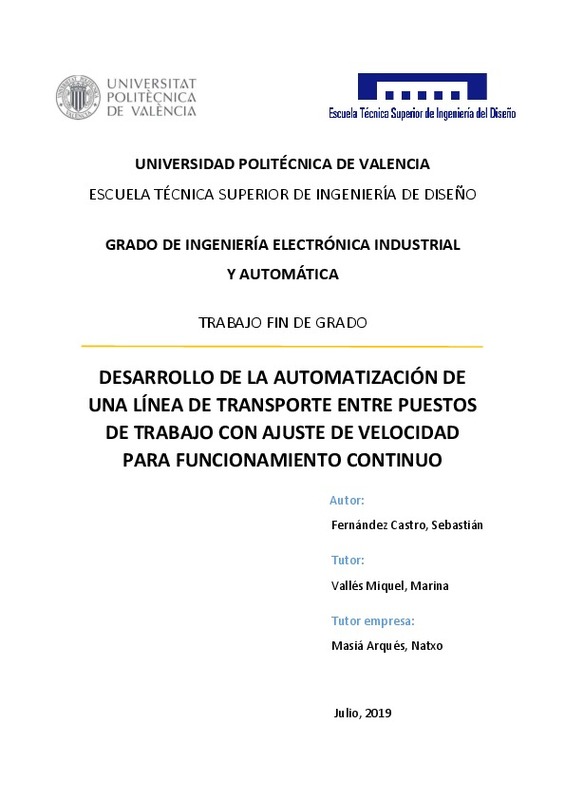|
Resumen:
|
[ES] Este TFG consiste en el desarrollo de la programación de un autómata Siemens para la automatización de una línea compuesta por 51 transportes con sus respectivos variadores, de los cuales 8 de ellos son transferidores ...[+]
[ES] Este TFG consiste en el desarrollo de la programación de un autómata Siemens para la automatización de una línea compuesta por 51 transportes con sus respectivos variadores, de los cuales 8 de ellos son transferidores o reenvíos (cambian de dirección la línea) y 4 puestos de trabajo. La fábrica a la que pertenece la línea produce moldes de ducha y el funcionamiento de la aplicación consiste en el transporte de unos tableros, sobre los cuales se pondrán unos moldes de distintas formas y tamaños, a lo largo de toda la línea, realizando el paro en los diferentes puestos de operador. Para ello, cada transporte debe cargar un tablero mientras descarga otro al mismo tiempo, a excepción de los transferidores, los cuales necesitan estar vacíos totalmente para poder cargar. En el caso de los trasferidores cambia el proceso. Los que reciben el material de manera horizontal tienen la condición en la búsqueda que los cilindros permanezcan abajo, cargando con rodillos y descargando con correas, mientras que los que reciben el material de manera vertical actuarán, al contrario, es decir, se encontrarán con los cilindros arriba, cargando con las correas y descargando con los rodillos. Por último, en cuanto a los puestos de trabajo, éstos se pueden habilitar o deshabilitar según se desee. Si se habilita el puesto, el tablero se quedará parado en dicho transporte hasta que el operario pulse el botón de confirmación de la correspondiente botonera. En el caso que no se habilite, funcionaría como un transporte normal. El TFG consta de la programación de la línea en Siemens, la programación de los variadores y la interfaz de usuario (HMI).
[-]
[EN] This TFG consists in the development of the programming of a Siemens automaton for the automation of a line composed of 51 transports with their respective drives, of which 8 of them are transferrs or forwarding (change ...[+]
[EN] This TFG consists in the development of the programming of a Siemens automaton for the automation of a line composed of 51 transports with their respective drives, of which 8 of them are transferrs or forwarding (change of direction of the line) and 4 jobs . The factory to which the line belongs produces shower molds and the operation of the application consists of transporting boards, on which molds of different shapes and sizes will be placed, along the entire line, making the stop in the different operator positions. For this, each transport must load a board while unloading another at the same time, with the exception of the transferrs, which need to be completely empty to load. In the case of transferrs the process changes. Those who receive the material horizontally have the condition in the search that the cylinders remain below, loading with rollers and unloading with belts, while those who receive the material vertically will act, on the contrary, that is, they will meet the cylinders up, loading with the straps and unloading with the rollers. Finally, in terms of jobs, these can be enabled or disabled as desired. If the position is enabled, the board will remain stopped in said transport until the operator presses the confirmation button of the corresponding keypad. In case it is not enabled, it would work as a normal transport. The TFG consists of the line programming in Siemens, the programming of the drives and the user interface (HMI).
[-]
|







